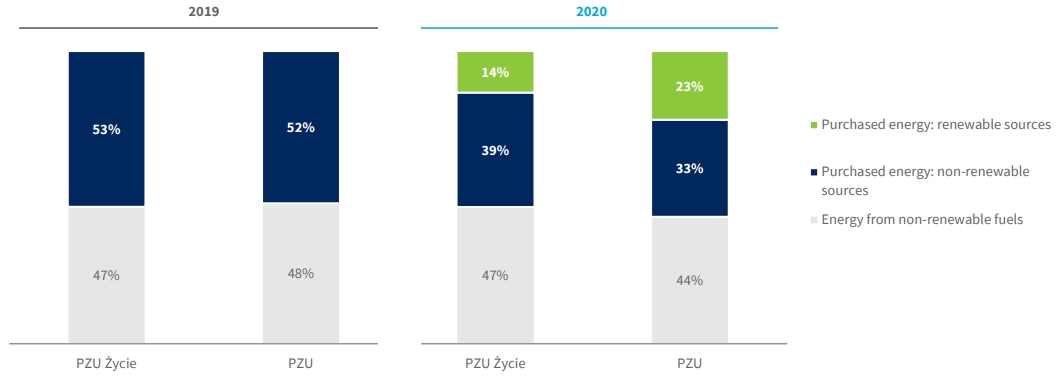PZU Group’s policies [Accounting Act]
[GRI 103-2]
The PZU Group’s responsible approach to business means translating it into a more ecological approach, i.e. one that reduces the adverse impact on the natural environment to the maximum degree. Environmental protection has been elevated to a strategic ranking. The pertinent clauses have been inserted into the “PZU Group’s corporate social responsibility strategy for 2018–2020”.
Implementing suitable procedures and governance systems allows the PZU Group to meet all the ecological legal and formal requirements. The Group does not confine itself to performing mandatory activities, but extends the extent of its initiatives in this area. The specially appointed Management Board Environmental Protection Plenipotentiary looks after consistency in environmental protection management in the PZU Group.
The PZU Group’s standard “Green PZU” was enacted in November 2018 as a follow-up to the Group’s strategic decisions, which was rolled out to ensure more efficient and improved efforts aimed at reducing the Group’s adverse environmental impact.
The PZU Group’s environmental standard defines the key assumptions pertaining to its governance approach to environmental issues.
They are embodied by these principles:
- sustainable development;
- high level of environmental protection;
- prudence and prediction of negative impact of our actions, if any;
- prevention of pollution and its elimination at source;
- inclusion of environmental protection elements into the business policy and strategy;
- partnership – the requirement for all PZU Group entities to take joint environmental protection actions.
Moreover, the Group has policies and documents in place that emphasize the significance of environmental protection efforts in day-to-day business practice.
The ISO 14001 Environmental Management System has been implemented and certified In the units of the subsidiary of PZU Zdrowie (POLMEDIC Radom). Companies operating in the health area have implemented in their selected medical centers and been certified under the ISO 9001:2015 quality management system. They also have in place a waste management procedure which defines, in particular, the rules for dealing with medical waste.
The environmental policy of Latvian-based AAS BALTA defines the company’s duties in the environmental protection domain. It also describes the environmental protection principles and defines the framework within which the company is required to adhere to these principles and thus achieve its objectives.
In Lithuania, Lietuvos Draudimas has in place a formalized environmental policy. Information on environmental protection matters is published in its annual reports and CSR reports.
The Pekao Group has in place the “Policy on optimization of energy consumption at Bank Polska Kasa Opieki Spółka Akcyjna”. The policy defines the standards and guidelines for the optimization of energy consumption at the Bank in line with environmental protection considerations. It is rooted in a commitment to proper monitoring and, to the extent possible, preventing any harmful environmental impact of the Group’s business. The duty of care for natural resources rests on the shoulders of all Bank employees, regardless of their position, seniority, place or extent of working time. For this reason, the pertinent provisions dealing with the protection of natural environment have been defined in the “Code of Conduct in the Pekao Group”.
Armatura Kraków has adopted a comprehensive “Quality Policy” which covers, among other issues, the principles for reducing the company’s adverse environmental impact.
[GRI 307-1]
In 2020, the PZU Group recorded no breaches of any environmental laws or regulations and incurred no environmental penalties.
The PZU Group seeks to reduce its direct environmental footprint in all areas of its business. Numerous initiatives are pursued by the Group with a view to minimizing this impact in activities related to real estate and the vehicle fleet. The objective is to reduce the consumption of commodities, materials and electricity in the Group’s business.
An increasing number of procurement decisions are made in consideration of the need to minimize the Group’s indirect environmental impact exerted across the value chain.
In addition to the adoption of various documents, the Group also makes efforts to minimize adverse environmental impact in its day-to-day business. The employees of the Real Estate Department and of the Administration Department undertake comprehensive activities to generate tangible effects provided for in the PZU Group’s environmental plan.
Direct environmental footprint of the Group:
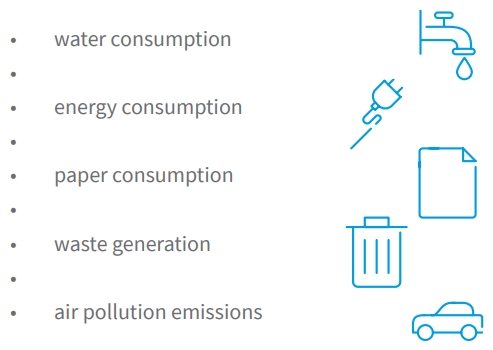
The Real Estate Department’s ecological plan:
- curtailing the consumption of utilities;
- conducting rational waste management;
- installing air conditioning with an ecological refrigerant;
- preferring environmental and social aspects when choosing space for rent;
- running educational campaigns among employees in terms of pro-environmental behaviors.
Activities in the administration area aimed at reducing adverse environmental impact:
- curtailing the consumption of office supplies;
- reducing the volume of hard-copy documentation;
- recycling of used assets;
- collaboration in the area of asset disposal with companies that have adopted the highest environmental protection standards;
- environmentally friendly activities in the car fleet management policy;
- conducting rational waste management;
- running educational campaigns among employees in terms of pro-environmental behaviors.
The program is a form of an environmental management system providing for the regular deployment of environmentally friendly solutions to the PZU Group’s operations.
BEST PRACTICE
Heating savings
This was another year when PZU and PZU Życie continued the work associated with thermal modernization of buildings – insulating walls and roofs, replacement of window joinery and central heating installation. Depleted heating boilers were replaced with modern and highly efficient devices with an option to adjust their operation to atmospheric conditions (weather controllers). Modern boilers produce heat while at the same time they save thermal and electrical energy and reduce the emissions of gases into the atmosphere.
In 2020 the consumption of energy generated and purchased by the PZU Group decreased by 10.2%, and the consumption of energy generated from non-renewable resources dropped by 16.1% while consumption of purchased energy dropped 6.3% y/y. This was caused by the pandemic and the resulting reduction of the use of the properties by the Group companies, and a number of efforts focused on reduction of raw material and energy consumption, and thermal modernization of the properties, modernization of the heat sources and replacement of lighting. A factor partly balancing these reductions, in particular consumption of purchased energy, was the further development of PZU Zdrowie and consolidation of two companies from the imaging diagnostics area which use energy-intensive devices, such as MRI, computer tomography and X-ray machines.
[GRI 302-4]
BEST PRACTICE
Energy savings
Implementation of the PZU Group’s “Green PZU” Standard
In 2020, the Real Estate Department continued its endeavors focused on reducing the consumption of heat and electricity, the emissions of gasses and expanding the volume of waste collected separately in real properties owned or used by PZU and PZU Życie. This way it implements the assumptions of PZU Group’s “Green PZU” Standard.
Completed activities:
- thermal modernization of 8 PZU and PZU Życie properties was carried out;
- power compensators were installed in 7 properties;
- the contracted power in 5 properties was reduced;
- internal LED lighting was installed in 21 properties;
- 14 image walls with LED lighting were installed;
- the heating installation or heating source in 10 properties was modernized and modified and thermal power in 2 properties was reduced;
- 7 heating boilers were replaced;
- 18 air conditioning devices using the environmentally friendly refrigerant R32 were installed.
In 2020, Bank Pekao continued to implement environment-friendly solutions, with special focus on those which limit electricity consumption and reduce the negative impact on the environment. These include primarily:
- implementation of the energy-saving LED lighting technology;
- optimization of energy consumption (reduction of the so-called contracted power);
- replacement of obsolete UPS devices with new ones with higher maximum efficiency;
- liquidation of redundant back-up power supply;
- installation of air conditioning systems with improved indicators, with special focus on solutions in the highest energy efficiency classes;
- replacement of air conditioning systems using refrigerants that have adverse impact on the environment with devices using a mix of environment-friendly gases;
- analyses leading to installation of devices compensating the reactive power (leading to elimination of unnecessary energy expenditures);
- switching electronic devices in the evening to standbymode.
In comprehensive modernizations of its properties the Bank uses modern solutions, e.g. energy-saving LED lighting systems or faucet aerators, leading to reduction of water consumption.
Energy Regulatory Authority (ERA) white certificates
Armatura Kraków obtained white certificates from ERA, which confirm the modernizations aiming at improving the energy efficiency and resulting in energy savings. Based on the obtained Energy Certificate No. PL 6589/4/F/69182/2021, the value of the certificate is: 705.641 toe, i.e. 29,544 GJ on average per annum for the next 7 years. The project was completed in October 2020 so its results will start to be fully visible in 2021.
[GRI 302-1]
PZU Group’s total consumption of energy from nonrenewable fuels
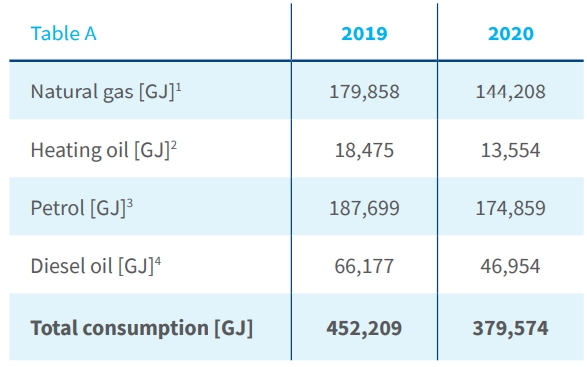
[GRI 302-1]
PZU Group’s total consumption of purchased energy
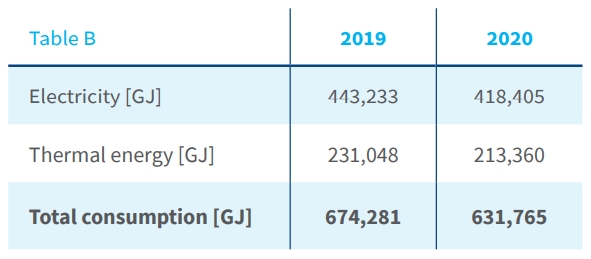
PZU Group’s total consumption of energy from non-renewable fuels and purchased energy

PZU and PZU Życie’s total consumption of energy from non-renewable fuels
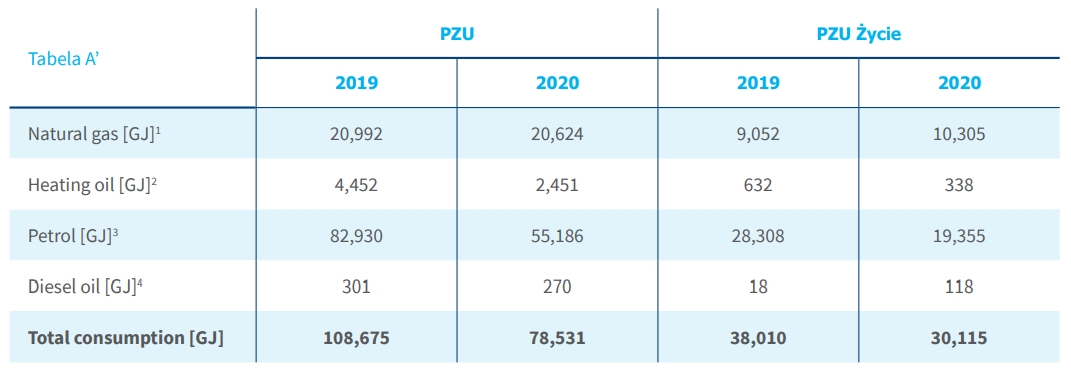
Total consumption of energy purchased in PZU and PZU Życie
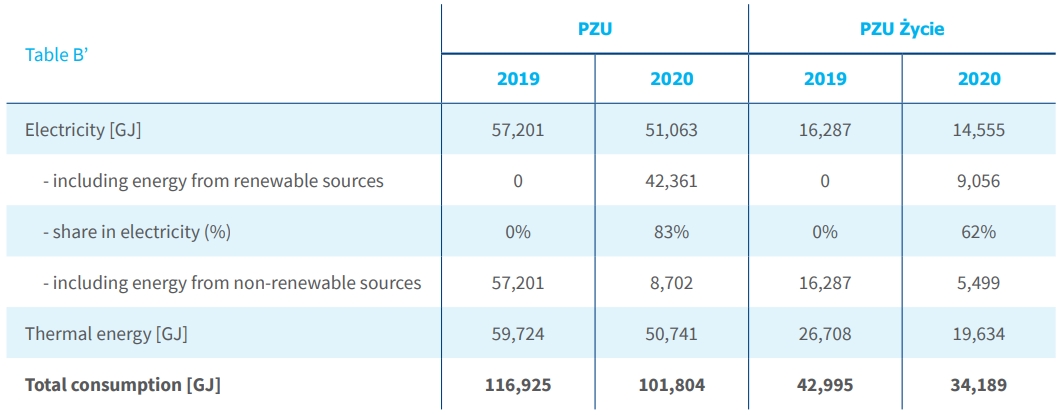
PZU and PZU Życie’s total consumption of energy from non-renewable fuels and purchased energy

The conversion of fuels into energy is based on the calorific values published by KOBIZE (National Centre for Emissions Management).
BEST PRACTICE
Electricity from renewable sources
In 2020, over 80% of the electricity contracted and purchased by PZU and over 60% of the electricity purchased by PZU Życie came from renewable sources (RES5).
Additionally, in 2020, in 12 properties PZU and PZU Życie installed photovoltaic panels – their total power was 248.05 kWp6.
Currently the process of connection of the installations to the power grid and implementation of the system monitoring the quantity of generated electricity is under way. This will enable the PZU Group to analyze on an ongoing basis the data on the energy generated from photovoltaics.
The use of electricity from RES, in addition to the economic aspect, has an important impact on climate protection through reduction of CO2 and other greenhouse gas emissions. It leads to reduction of scope 2 emissions through reducing the demand for energy and, as a consequence, reduction of the use of fossil fuels for production of energy from high-emission sources. The cost savings regarding the electricity consumed for 12 properties in which photovoltaic panels were installed are in the range of 25%.
Thanks to the purchase of electricity with certificates of origin by PZU and PZU Życie, its share in total energy consumption (purchased energy and energy from fuels) amounted to 23% and 14%, respectively. In the years to come, further use of RES and increase in the share of green energy, subject to its availability in the market, is planned.
The share of renewable sources in total energy consumption at PZU and PZU Życie
CO2e emissions in the PZU Group
Below are the data on the total direct and indirect emissions for the whole PZU Group and for the main insurance companies: PZU and PZU Życie. The calculations of the carbon footprint were made in accordance with the international GHG Protocol Corporate Accounting and Reporting Standard. 2018 was selected as the base year.
In 2020 the PZU Group took multidirectional measures aimed at reduction of its emissions in scope 1 and 2, among others through purchase of energy from renewable sources and purchase of energy from suppliers characterized by lower emission rates. To illustrate the impact of these measures on the Group’s total emissions, the data on scope 2 (indirect emissions) were enriched by a calculation of the emissions using the market-based method, which more fully reflects the impact of the actions taken, thanks to the use of emission rates specific to respective electricity sellers. In addition, the scope of emissions reporting in all scopes was expanded in the PZU Group companies, i.e. outside PZU and PZU Życie.
BEST PRACTICE
Reduction of CO2 emissions
PZU and PZU Życie took actions aimed at reducing scope 1 greenhouse gas emissions associated with combustion of fuels. To this effect, in 2020, the companies expanded their fleet by 24 hybrid and electric cars. It is estimates that this will translate into reduction of the annual CO2e emissions by 42.3 tons* in 2021.
For 2021, actions are planned to contribute to further reduction of indirect emissions:
- development of the sustainable business travel model;
- use of the services of transport companies with electric and hybrid fleets; ,
- cooperation with hotels that offer high environmental standards.
*For the needs of measuring CO2e emissions, the fuel consumption (liters) was adopted and then CO2e converted to tons.
[GRI 305-1]
Total direct emissions (scope 1) in the PZU Group

Emissions (scope 1) 2020 vs. 2019
Total direct emissions in scope 1 in the PZU Group reached 25.8 thousand tons of CO2e, compared to 30.5 thousand tons of CO2e in 2019, down 15.4% (-4.7 thousand tons y/y). The decrease resulted largely from lower fuel consumption as a result of the restrictions introduced due to the state of epidemic in Poland. The lockdown and travel restrictions, and transitioning to remote work translated into lower utilization of company cars and lower consumption of utilities in operating activities. In particular, emissions associated with consumption of petrol, natural gas and heating oil were reduced. Numerous initiatives aiming to reduce scope 1 emissions were conducted; among others the installations were modernized and heating boilers replaced. Additionally, already in previous years PZU and PZU Życie began installing air conditioning devices containing new environmentally friendly refrigerant R32 which has a third of the GWP (greenhouse effect potential) compared to standard refrigerants. In 2020, 18 such air conditioning devices were installed. In PZU, PZU Życie and both PZU Group banks, the cars in the fleet were replaced with models which produce lower CO2e emissions.
The decrease in scope 1 emissions in 2020 occurred despite the change (expansion) of the reporting scope. From 2020, data are collected in all Group companies on the refrigerant leakages (from 2019 only in PZU and PZU Życie). Despite the broader reporting scope, emissions from this source dropped by 3.6% y/y. On comparable basis, the decrease in greenhouse gas emissions on account of refrigerants would amount to 66% y/y, and the decrease in scope 1 emissions would amount to 18% y/y9.
Emissions (scope 1) 2020 vs. 2018
Total scope 1 emissions dropped 17.9% relative to the base year (2018), including emissions associated with refrigerant leakages were 37.7% lower, despite including additional PZU Group companies in the reporting, and emissions associated with fuels dropped by 16.5% compared to the base year. As in the 2019 report, the calculations were made for the facilities where consumption was measured. In the case of consumption of natural gas by PZU and PZU Życie (total), they pertain to approx. 90% of the surface of the properties used by these companies.
[GRI 305-2]
Total indirect emissions (scope 2) in the PZU Group – market-based method
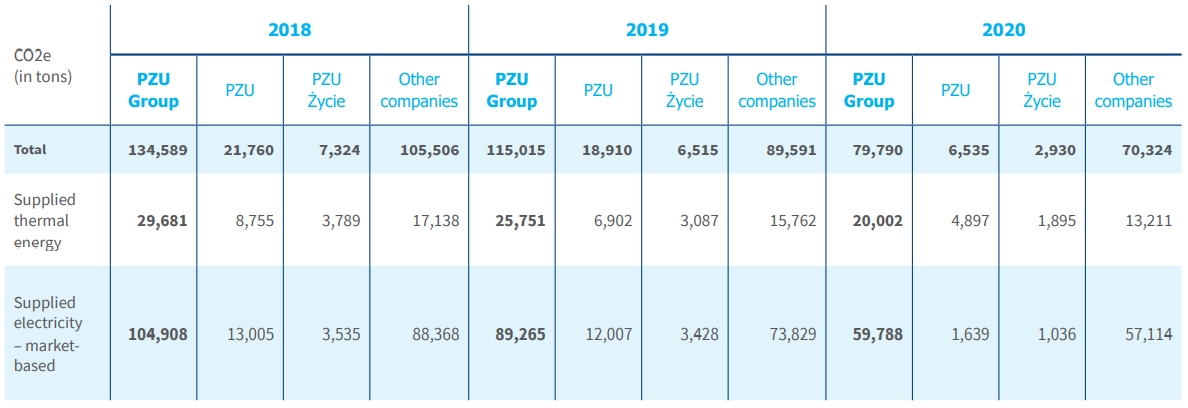
Emissions (scope 2 – market-based) 2020 vs. 2019
Market-based indirect scope 2 emissions reached 79.8 thousand tons of CO2e in 2020 compared to 115 thousand tons in 2019, which signifies a decrease by 30.6% y/y (-35.2 thousand tons). They resulted from lower emissions associated with supplied electricity (-33.0%, -29.4 thousand tons) and heat (-22.3%, -5.7 thousand tons).
For electricity, the decrease resulted largely from the purchase of electricity with certificates of origin (impact on emissions was estimated at -10.7 thousand tons) and from the purchase of energy from suppliers characterized by lower emission rates (-12.3 thousand tons). Other contributing factors included lower use of energy and lower emission rates of the remaining electricity suppliers. On the other hand, the increase in emissions was also attributable to further development of the PZU Zdrowie Group, in particular, consolidation of two companies from the imaging diagnostics area which use energy-intensive devices, such as MRI, computer tomography and X-ray machines (impact in the range of approx. 3 thousand tons).
Emissions associated with heat dropped by 22.3% (-5.7 thousand tons y/y). The decrease was related to lower utilization of heating energy (-7.7%) and reduction of total emission rates in Poland.
Additionally, the above trends were driven by the reduction initiatives undertaken by the Group in the area of own properties and such efforts as, for example, thermal modernizations, installation of power compensators, replacement of lighting with energy-saving solutions, and optimization of energy consumption through reduction of contracted power. Electricity and heat consumption was also reduced due to introduction of the state of epidemic in Poland, bulk of the employees working in the remote work system and shutdown of production plants of the PZU Group companies.
Emissions (scope 2 – market-based) 2020 vs. 2018
Total scope 2 emissions calculated using the market-based method dropped 40.7% relative to the base year (2018), including emissions associated with supply of heat were 32.6% lower, and emissions associated with electricity dropped by 43.0% compared to the base year. As in the 2019 report, the calculations were made for the facilities where consumptions are measured. In the case of PZU and PZU Życie (total) they pertain to approx. 90% of the surface of the properties used by these companies for electricity consumption and approx. 80% for heat consumption.
[GRI 305-2]
Total indirect emissions (scope 2) in the PZU Group – location-based method
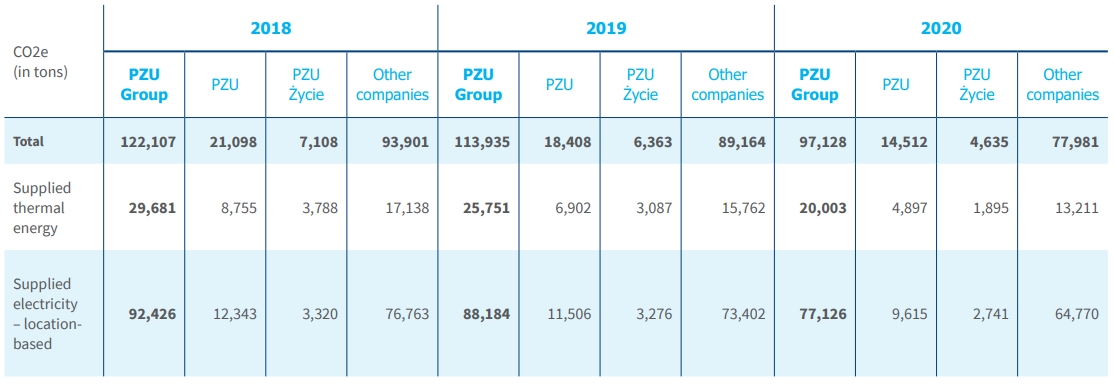
Emissions (scope 2 – location-based) 2020 vs. 2019
Location-based indirect scope 2 emissions reached 97.1 thousand tons of CO2e in 2020 compared to 113.9 thousand tons in 2019, which signifies a decrease by 15% y/y (-16.8 thousand tons). The decrease is less pronounced than in the case of the market-based method, because the location-based method does not take into account certificates of origin or differences in the emission rates of individual suppliers.
The reduction of scope 2 emissions measured with the location-based method was attributable to reduced emissions associated with the lower consumption of electricity (-11.1 thousand tons CO2e) and heat (-5.7 thousand tons CO2e). In both sources, the lower emissions resulted both from the decrease of energy consumption and decrease of total emission indicators in Poland.
Emissions (scope 2 – location-based) 2020 vs. 2018
Total scope 2 emissions calculated using the location-based method dropped 20.5% relative to the base year (2018), including emissions associated with supply of heat were 32.6% lower, and emissions associated with supply of electricity dropped by 16.6% compared to the base year.
Emissions 2020 (scope) – location-based vs. market-based
Comparing the results obtained using the location-based and the market-based method, one can see the management approach to selection of suppliers due to emission rates and purchase of energy from renewable sources. In PZU and PZU Życie, total scope 2 emissions (calculated using the marketbased method) in 2020 stood at 9.5 thousand tons CO2e, which is two times lower than the result achieved without taking into account the emission rates of the suppliers and the energy from RES (location-based). The share of PZU and PZU Życie in the Group’s total scope 1 and 2 emissions (calculated using the market-based method) dropped in 2020 by 9.1 p.p. y/y to 16.1%
The share of PZU and PZU Życie in the Group’s emissions of greenhouse gas (Scope 1 and 2)
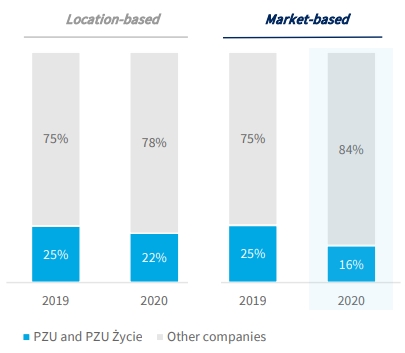
[GRI 305-3]
Total of other indirect emissions (scope 3) in the PZU Group
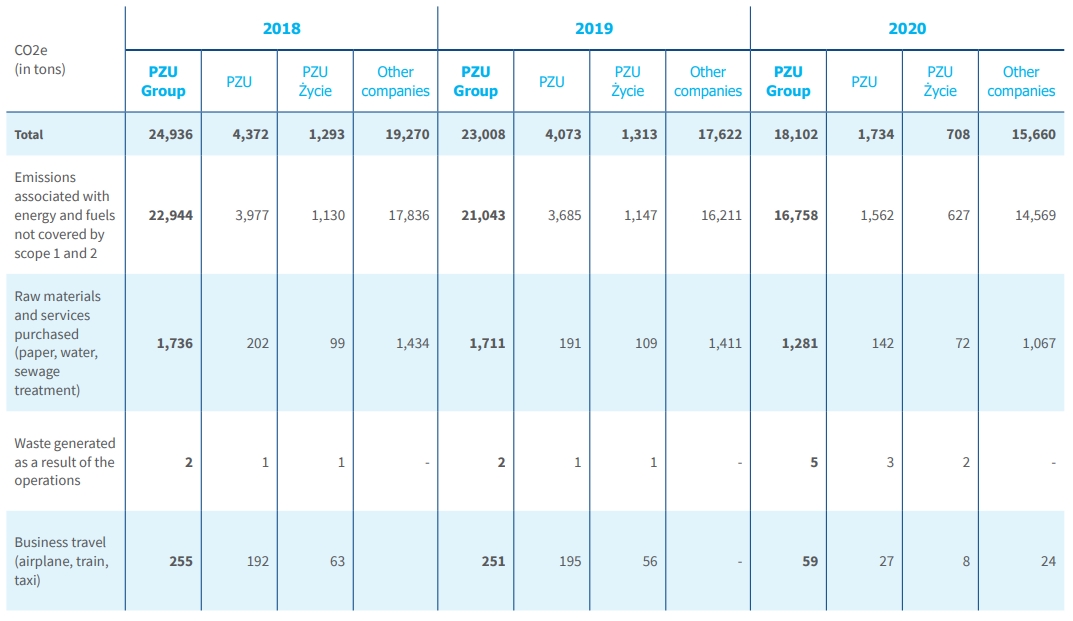
Emissions (scope 3) 2020 vs. 2019
Scope 3 (indirect) emissions in categories10 1, 3, 5 and 6 (listed in the table above) by the PZU Group reached 18.1 thousand tons of CO2e compared to 23 thousand tons in 2019 (-21.3% y/y or -4.9 thousand tons). The decrease occurred predominantly in emissions related to energy and fuels in the value chain and was chiefly due to the purchase of energy with certificates of origin, which entails lower indirect emissions (impact of approx. 1.5 thousand tons) and a decrease in electricity consumption. Also emissions associated with purchased raw materials and services, in particular paper were lower and emissions associated with business travel, despite the expanded reporting on the emissions from this source, were reduced by 76.5%. This resulted mainly from the travel, including business travel, restrictions imposed. In the future, the scope of reporting is expected to cover more categories provided for in the standard and more PZU Group’s consolidated companies.
Emissions (scope 3) 2020 vs. 2018
Scope 3 (indirect) emissions in selected categories dropped by 27.4% relative to the base year (2018), with the reduction of emissions associated with energy and fuels not captured in scope 1 and 2 being the biggest contributor to the decrease.
Calculation methodology
For the calculation of emissions in accordance with the GHG Protocol standard, for fuels, electricity (consumed in Poland), emission indicators or data from the National Center for Emissions Balancing and Management were used, while for heat (consumed in Poland) the indicator of the Energy Regulatory Office was used (based on the publication “Heating Energy in Numbers 2019”). The emission indicators for electricity consumed in foreign companies for 2020 were obtained from data published by the European Environment Agency (in previous years from the International Energy Agency), while those for heat energy were obtained from the UK Government’s Department of the Environment, Food and Rural Affairs (DEFRA) database. For scope 2 emissions calculated according to the location-based method, average emission ratios for the respective countries were used. The indicators for electricity from a specific supplier (market-based method) came from the websites of energy sellers (among others Enea, Energa, PGE, Innogy Polska, Tauron Sprzedaż, Tauron Sprzedaż GZE, Tauron Polska Energia, PKN Orlen, ENGIE Zielona Energia).
The emission indicators for energy in the scope of WTT (well to tank) (scope 3), business trips, purchased raw materials and services, waste management and GWP for refrigerants were obtained from the DEFRA database. No biogenic greenhouse gas emissions were identified.
The following data sources were used: fuel, electricity and heat consumption came from the invoices for facilities where the consumption is measured. For PZU and PZU Życie, this pertained approx. 90% of the area of facilities for electricity consumption, approx. 90% of the area of facilities for natural gas and approx. 80% of the area of facilities for thermal energy. For the other PZU Group companies, according to the data reported by them. Consumption of raw materials, refrigerants, waste volumes and business travel was determined on the basis of internal registers. Data that are not collected from the remaining companies were marked in the table with a dash.
The greenhouse gas described in the emission indicators for fuels, electricity and heat in Poland is CO2. The other indicators included CO2, CH4 and N2O emissions as well as refrigerant gases. The volume of emissions released by each company was consolidated at the PZU Group level according to the operational control criterion.
Below are presented the greenhouse gas emissions taking into account the consolidated assets and number of employees.
[GRI 305-4]
Intensity of greenhouse gas emissions
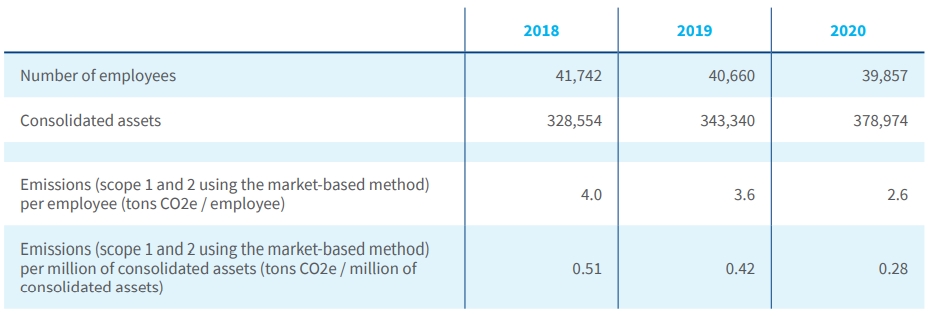
As a result of the actions taken to reduce emission rates, reduce energy and fuel consumption and emission rates in Poland, the intensity of scope 1 and 2 emissions using the market-based method per employee dropped from 4.0 in the base year and 3.6 in 2019 to 2.6 tons CO2e in 2020. Emissions per million zloty of consolidated assets dropped from 0.51 in the base year and 0.42 in 2019 to 0.28 tons CO2e in 2020.
The PZU Group was on the list of climate leaders – the first ranking of Polish companies with the biggest reduction of greenhouse gases (GHG) organized by “Forbes Polska” and Statista, company specializing in market and consumer data. The aim of the ranking is to distinguish companies that are the most aware of their challenges regarding greenhouse gas emissions, showing at the same time respect for the environment.
[GRI 305-5]
Reduction of greenhouse gas emissions
The PZU Group, in particular PZU and PZU Życie, reduced emissions by 10.7 thousand tons CO2e in 2020 through purchase of energy with certificates of origin. The reduction was recorded in scope 2 and calculated as the sum of products of the purchased electricity from individual suppliers multiplied by appropriate emission indicators shown for these sellers.
In addition, Armatura Kraków obtained white certificates from ERA, which confirm the modernizations aiming at improving the energy efficiency and resulting in energy savings. The value of the obtained Energy Efficiency Certificate 705.641 toe, i.e. 29,544 GJ on average per annum over the next 7 years. The project was completed in October 2020 so its results will start to be fully visible in 2021. This will translate into CO2e emission reductions by 1.6 thousand tons CO2 in scope 1 going forward.
Total CO2 emissions (Scope 1, 2 and 3) in PZU Capital Group by emissions sources
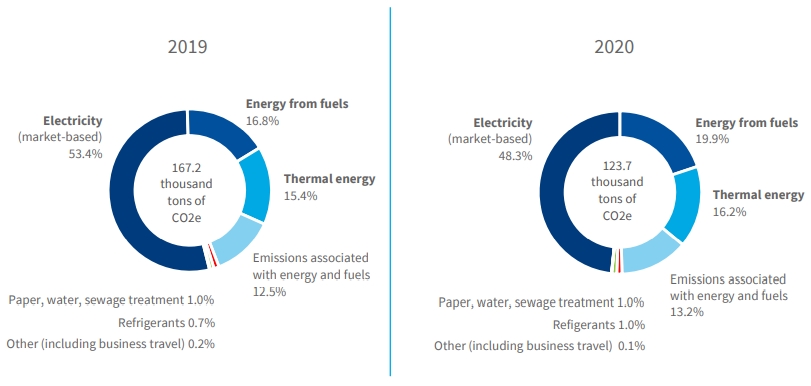
To further reduce the carbon footprint the PZU Group undertakes numerous initiatives aimed at limiting the consumption of raw materials in the company’s current operations. Consumption of raw materials in the entire Group, and separately for PZU and PZU Życie, is presented in the table below.
[GRI 301-1]
Total consumption of raw materials in the PZU Group

[GRI 301-1]
Total consumption of raw materials at PZU and PZU Życie

BEST PRACTICE
Paperless in mass printing
PZU and PZU Życie strive to increase the volume of electronic mailing. Based on the granted consents, hardcopy communication with the client is replaced with electronic communication. During the year, the number of clients with whom the companies contact electronically increased by five times. The number of policy renewal emails in 2020 exceeded 1 million. This translated into savings estimated at 32.2 tons of paper per annum, i.e. 24.8 Mg equivalent of carbon dioxide.
In 2020 (December to January):
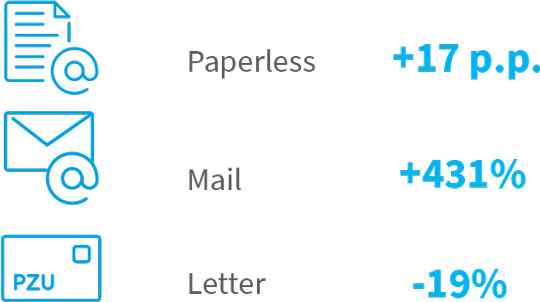
Paper consumption at PZU and PZU Życie
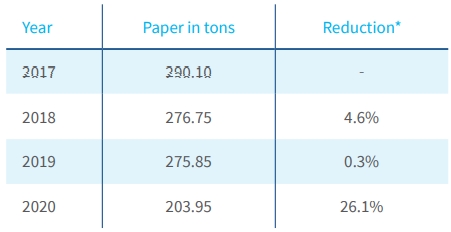
* The ordered quantity of paper depends strongly on the volume of sales of PZU products; 80% of the paper is consumed by the sales units. The pandemic caused an unnatural reduction on the number of printouts and hence paper consumption so 2021 may bring an increase in paper consumption relative to 2020
BEST PRACTICE
Optimization of purchase and consumption of office supplies
PZU and PZU Życie systematically reduce the purchase and consumption of office supplies, including paper, constantly reducing the number of printers used. All new printing devices are equipped with an automatic two-sided printing (duplex) module – wherever the specific nature of work permits two-sided printing, it is set as the default printing option. From 1 October 2020, only the environment-friendly paper with lower basis weight – Discovery Eco-Efficient 70 g/m2 – has been purchased and used, and instead of the POL Copy 80 g/m2 paper purchased in the past, the same change of paper type to a thinner one leads to an over 8% reduction of the weight of the paper consumed. Additionally, the Discovery paper is produced from the Tasmanian Blue Gum eucalyptus tree which, thanks to a different fiber structure, makes it possible to reach a ca. 37% reduction of the wood used for paper production in relation to the commonly used trees, such as maritime pine or paper birch. Additionally, PZU and PZU Życie started actions associated with the use of paper with FSC and PEFC certificates. At least 50% of the insurance forms in terms of the weight are prepared on certified paper.
Step 1: Increase of the share of suppliers offering paper with certificates for production of forms. In 2020, one more of the suppliers implemented an appropriate certificate;
Step 2: Specification of the product range which can be printed on certified paper. These are general terms and conditions of insurance, payment forms and bases, ordered by PZU in large quantities;
Step 3: Current monitoring of the share of certified raw materials among other printing materials.
BEST PRACTICE
Alior Bank introduced restrictions regarding document printout through optimizing the printing process. The use of company printers is possible only after the employee logs into the device, which prevents incidental printouts and improves the management of paper and toner consumption. Additionally, printers are set by default to double-side printing. Alior Bank consistently implements the “paperless bank” idea, which allows it to reduce paper consumption every year.
BEST PRACTICE
Armatura Kraków replaced radiator packaging from boxes to the so called “sides”. This effort brought savings in the range of 43 tons of paper per year, which is nearly 26% of the annual consumption.
BEST PRACTICE
TOW “SOS Service Ukraine” implemented partly electronic document flow to minimize paper consumption. Actions were taken to reuse paper and recycle used paper. An agreement was signed with a company which supplies the offices with special boxes for collection and processing of paper.
In addition to reduction of raw material consumption and reduction of greenhouse gas emissions, the PZU Group takes actions reducing the number of printing devices used:
- withdrawal of printers with the least usage;
- printing via shared multi-function devices;
- introduction of printer sharing in the branches where the desk layout allows for that.
Reduction of the number of printers at PZU and PZU Życie
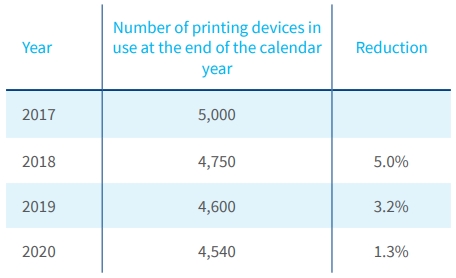
PZU and PZU Życie apply a sustainable and responsible approach to disposal and reuse of assets following the “5 R” principle:
- Reduce;
- Reuse;
- Recycle;
- Recover;
- Renew.
This principle encourages employees to renew and repair older things to extend the time of their operation. The companies cooperate with firms offering the highest waste management standards, confirmed by pertinent environmental certificates. PZU and PZU Życie set an objective of increasing the share of recycling in the total number of liquidated assets from 33% at the end of 2018 to 40% at the end of 2020. This ratio was attained thanks to promotion of sale of assets to companies and external customers or donations. Additionally, collections of used mobile phones are held regularly and the devices are sold to a specialized company (recycling).
Potential benefits resulting from reduction of printing devices and reuse of assets:
- lower volume of generated e-waste;
- lower electricity consumption;
- lower inventories as a result of standardizing the consumables and printing devise models used.
Achieved results:
The volume of used mobile phones and modems for recycling and sale to the company employees is as follows:
- 2018 – 2,602 pcs.
- 2019 – 2,030 pcs.
- 2020 – over 3,000 pcs.
Change of the water distribution method
Reduction of distribution of water in big plastic bottles in favor of water dispensers using water from the water supply system, use of running water filters or consumption of water directly from the tap in places where water is good to drink will result in:
- reduction of the number of plastic packages in circulation (to be disposed of);
- optimization of water use;
- limiting CO2 emissions due to reduction of transport;
- reduction of the quantity of energy and raw materials needed to produce big plastic bottles.
[GRI 303-5]
Total consumption of water in the PZU Group

[GRI 303-5]
Total consumption of water by PZU and PZU Życie

BEST PRACTICE
As part of waste management, Bank Pekao regularly hands over paper documentation, computer media, furniture, and white and brown goods for specialized disposal. When ordering new white and brown goods, the company takes into account the service involving collection and disposal of old goods. At the turn of 2019/2020 the bank started to install bottle, can and drink carton crushers. Current waste is segregated in five categories, according to the prevailing Regulation issued by the Environment Minister. The bank continued the employee information campaign on rules for segregation of waste in the head office and field offices launched in 2018.
Planned reduction in the number of water dispensers and big water bottles*

* In PZU locations in which the technical conditions allow for that, running water dispensers are successively installed. In the dispensers water from the water supply system is treated in a multi-level filtration process, after which it can be collected as cold, room temperature or hot water
** Due to the COVID-19 situation, the agreement on the dispensers (big plastic water bottles) was extended by 8 months till the end of February 2022. This extension will also allow for organizing a single tender procedure for the network dispensers nationwide.
BEST PRACTICE
Involvement of PZU and PZU Życie employees in environmental efforts and building sustainable development awareness
The PZU Group is one of the largest employers in Poland. It is aware that building responsible employee attitudes contributes also to reduction of the negative environmental impact. Regular activities are undertaken to encourage employees to save paper by reducing the number of printouts in PZU outlets throughout Poland (back-office):
- stickers encouraging reduction of printouts with the slogan “If you don’t have to, don’t print. Green PZU”;
- reduction of printout of posters and leaflets in internal communication.
Communication and educational campaigns promoting environmental behaviors:
- black and white and double-sided printouts;
- reduction of printouts through messages: do not copy – scan, this does not cost anything, use the print view – avoid poor printout formatting, hold paperless meetings – use a projector;
- eco-driving (education on environment-friendly use of the car at the company car driver portal on PZU’s website);
- information campaigns pertaining to recycling of used mobile phones;
- educational campaign “you don’t need it – give it to others” encouraging hand-over of redundant office supplies to other employees for use. Exchange spots were designated and sign-posted. The aim was to increase environmental awareness, reduce the volume of materials for disposal and reduce the cost of purchase of office supplies;
- additionally, in each issue of the internal employee newsletter “My PZU”, articles are published raising key environmental issues.
In 2020, on the occasion of the Global Day of Action for Sustainable Development, the “SDG (Sustainable Development Goals) Challenge” contest, i.e. how PZU may stimulate sustainable development?” was organized for employees to come up with innovative business ideas. The contest was carried out via the Idea Generator, a platform for exchange of ideas and comments by PZU Group employees. In this edition of the contest, ideas were sought for business initiatives which will support the execution of selected Sustainable Development Goals. PZU Group employees shared as many as 57 ideas responding to the contest challenge. These were often comprehensive solutions prepared by several employees. The organization of this edition of the Idea Generator contest is an example of not only effective cooperation between the departments and the innovative approach to supporting employees in development of competences that go beyond their daily duties, but also building sustainable development awareness. Based on specific criteria, the contest jury selected 10 best ideas, with the winning three receiving financial awards. The best ideas were handed over to business units for in-depth analysis.
1 Calorific value of natural gas at 36.54 MJ/m3 in 2020 and 36.62 MJ/m3 in 2019
2 Calorific value of heating oil at 43 MJ/kgin 2020 and 2019
3 Calorific value of petrol at 44.3 MJ/kgin 2020 and 2019
4 Calorific value of Diesel oil at 43 MJ/kgin 2020 and 2019
5 RES - total resources used for production of electricity and heat whose long-term use does not cause a significant deficit or which are renewed over a short time. These sources include: wind power, solar radiation power, geothermal power, hydropower, wave power, tidal power, salt gradient and flow power, power obtained from biomass, biogas and biofuels
6 kWp - defines the efficiency that can be achieved by photovoltaic panels if they work in standard measurement conditions – how much electricity (1 kWh) the given panel or the whole photovoltaic installation is able to produce
7 CO2e - carbon dioxide equivalent, universal unit used for measurement of greenhouse gas emissions which reflects their different global warming factor. It defines the concentration of carbon dioxide whose emission into the atmosphere would have an identical impact at the concentration of a comparable greenhouse gas
8 The PZU Group collects data on the consumption of the following fuels: petrol, Diesel oil, natural gas and heating oil
9 emissions in the base year were not converted for consolidation as the adopted materiality criteria were not satisfied
10 in the accordance with the GHG Protocol methodology https://ghgprotocol.org/









